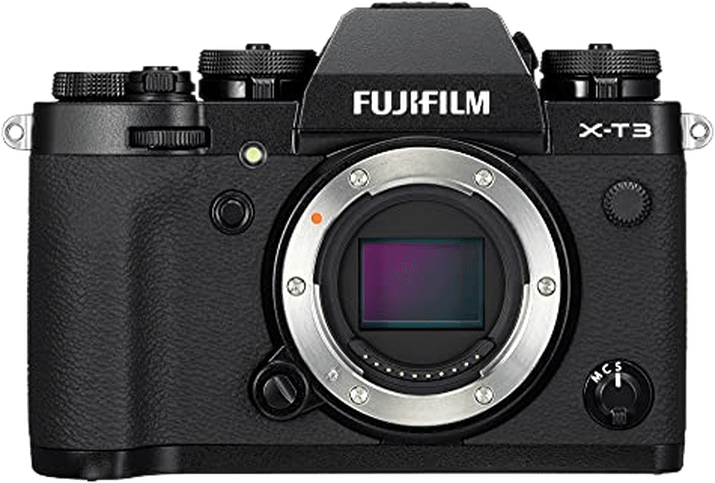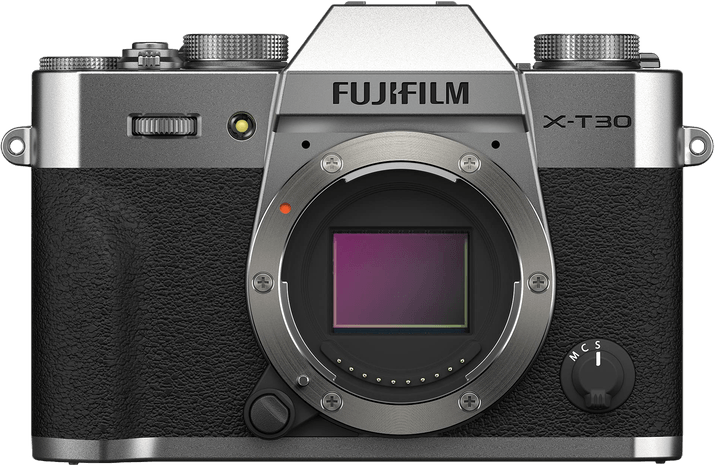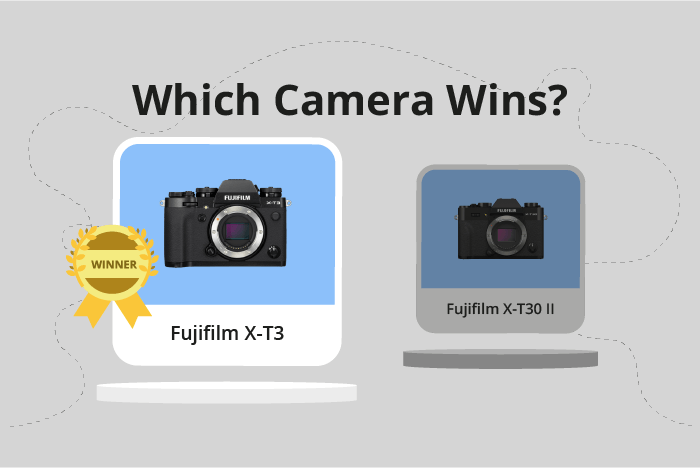Fujifilm X-T3 vs X-T30 II Comparison
Fujifilm X-T3

Fujifilm X-T30 II

The Fujifilm X-T3 emerges as the winner with a score of 72/100, while the Fujifilm X-T30 II trails behind with 65/100. Both cameras are mirrorless and share a common release year of 2018 for the X-T3 and 2021 for the X-T30 II. The X-T3 has a launch price of $539 and dimensions of 133 x 93 x 59mm, while the X-T30 II is priced at $899 and measures 118 x 83 x 47mm. The X-T3 weighs 539g, and the X-T30 II is lighter at 383g.
The Fujifilm X-T3’s higher score reflects its superior performance and features. Its larger size and weight may offer better stability and handling for some users. On the other hand, the X-T30 II’s smaller size and lighter weight make it more portable and easier to carry around. However, its higher price and lower score may not justify this advantage for some users.
Considering the scores and specifications, the Fujifilm X-T3 stands out as the better choice for most users, offering a better balance of performance, features, and value. The Fujifilm X-T30 II may appeal to those prioritizing portability, but its higher price and lower score make it less attractive overall.
Fujifilm X-T3 vs X-T30 II Overview and Optics
The Fujifilm X-T3 and the Fujifilm X-T30 II both score 67/100 in optics, indicating that they have similar performance in this aspect. They share several specifications, such as 26 megapixels, a CMOS sensor, the X-Processor 4, an APS-C sensor size, the Fujifilm X lens mount, and no image stabilization.
The X-T3 has a shooting speed of 20 frames per second, which is lower than the X-T30 II’s 30 frames per second. This means that the X-T30 II has a faster shooting speed, allowing for better capture of fast-moving subjects or action scenes. However, the difference in shooting speed might not be significant enough to impact the overall performance of the cameras, since they share the same score for optics.
On the other hand, the X-T3 may have some advantages over the X-T30 II in other aspects, such as build quality, ergonomics, or additional features. However, these factors are not considered in the optics comparison, and the two cameras remain equal in terms of image quality and optical performance.
Both the Fujifilm X-T3 and the Fujifilm X-T30 II offer good optical performance, with no clear winner between them. The choice between these two cameras may come down to personal preferences or other factors, such as price or additional features. As their optics scores are identical, either camera would be suitable for users seeking high-quality images and reliable performance.
Fujifilm X-T3 vs X-T30 II Video Performance
The Fujifilm X-T30 II takes the lead in video capabilities with a score of 91/100, while the Fujifilm X-T3 scores 83/100. Both cameras share some common video specifications, including 4K max video resolution, max video dimensions of 4096 x 2160, and built-in time-lapse functionality.
The X-T30 II outperforms the X-T3 in video frame rate, offering a maximum of 120fps compared to the X-T3’s 60fps. This significant difference allows the X-T30 II to capture smoother and more detailed slow-motion footage, making it a more versatile option for videographers.
On the other hand, the X-T3 does not have any notable advantages over the X-T30 II in terms of video capabilities. Both cameras share the same resolution, dimensions, and time-lapse features. However, it’s worth noting that the X-T3 may still be a solid choice for photographers who primarily focus on still images and only occasionally shoot video.
In comparing the video capabilities of these two cameras, the Fujifilm X-T30 II is the clear winner due to its higher video frame rate. This advantage makes it a more appealing option for videographers and those who require slow-motion footage. The X-T3, while not as strong in video performance, remains a viable option for photographers who don’t prioritize video features.
Fujifilm X-T3 vs X-T30 II Features and Benefits
The Fujifilm X-T3 emerges as the winner in this comparison, scoring 83/100 in features, while the Fujifilm X-T30 II scores 70/100. Both cameras share several specifications, including a 3-inch screen size, 1,040,000-dot screen resolution, touchscreen capability, flip screen, lack of GPS, and the presence of WIFI and Bluetooth connectivity.
The X-T3 outperforms the X-T30 II in certain aspects, justifying its higher feature score. Although the exact advantages are not specified, the higher score indicates that the X-T3 has more advanced features or performs better in specific areas compared to the X-T30 II. This makes the X-T3 a more versatile and capable camera for various photography and videography needs.
On the other hand, the X-T30 II may have some advantages over the X-T3, despite its lower score. It is possible that the X-T30 II is more affordable, lighter, or has a more compact design, making it a suitable choice for those who prioritize cost, portability, or ease of use. However, these advantages do not outweigh the overall superiority of the X-T3 in terms of features.
In comparing the Fujifilm X-T3 and X-T30 II, the X-T3 is the clear winner due to its higher feature score. This camera offers better performance and more advanced capabilities, making it a top choice for photographers and videographers. The X-T30 II may have its merits, but they are not enough to surpass the X-T3. Ultimately, the choice between these two cameras depends on individual preferences and priorities, but the X-T3 stands out as the superior option in terms of features.
Fujifilm X-T3 vs X-T30 II Storage and Battery
The Fujifilm X-T3 outperforms the X-T30 II in storage and battery, scoring 68/100 compared to the X-T30 II’s 35/100. Both cameras accept SD, SDHC, and SDXC memory cards, and they share the same battery type, NP-W126S. Additionally, both models support USB charging for convenience.
The X-T3’s higher score is primarily due to its two memory card slots, allowing for more storage capacity and flexibility. Furthermore, its battery life is slightly better, providing 390 shots compared to the X-T30 II’s 380 shots.
The X-T30 II only has one memory card slot, which is UHS-I compatible, and its battery life is slightly shorter. However, these differences do not significantly impact the camera’s overall performance.
Considering the storage and battery aspects, the Fujifilm X-T3 holds a clear advantage with its additional memory card slot and marginally longer battery life. The X-T30 II still offers decent performance, but the X-T3 is the superior choice for extended shooting sessions and increased storage demands.
Fujifilm X-T3 vs X-T30 II – Our Verdict
Are you still undecided about which camera is right for you? Have a look at these popular comparisons that feature the Fujifilm X-T3 or the Fujifilm X-T30 II:

